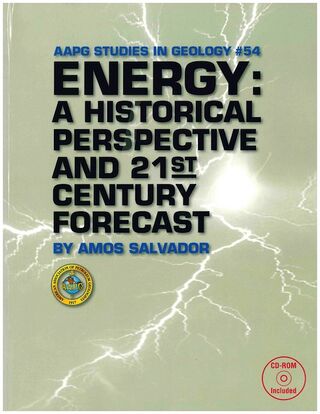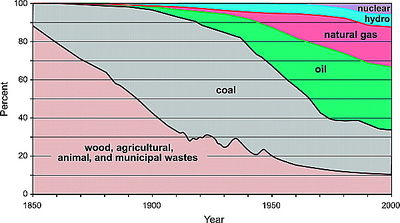Energy: historical sources
| Energy: A Historical Perspective and 21st Century Forecast | |

| |
| Series | Studies in Geology |
|---|---|
| Chapter | Sources of Energy |
| Author | Dr. Amos Salvador |
| Link | Web page |
| PDF file (requires access) | |
The main sources of energy at the beginning of the 21st century are divided into two types: nonrenewable (oil, natural gas, coal, tar sands, oil shales) and renewable (nuclear, hydroelectric, geothermal, solar).
Sources of energy used by mankind have changed widely. Similar changes should be expected in the future. Figure 1 depicts the changes of energy sources over a 150-year period.
Wood and other plant materials were first used by early humans as fuel for fire. Many centuries later, they added wind and running water as new sources of energy. The use of coal as a fuel, limited until the mid-19th century, grew dramatically during the Industrial Revolution, with coal replacing wood as the main source of energy in many regions of the world. Coal, in turn, was progressively replaced by oil during the first have of the 20th century, and by the mid-1960s, oil became the main source of energy. During the last decade of the 20th century, oil has provided 37% of the world's energy supply. At the same time, the contribution of natural gas to the total world supply of energy, which was minor in the first half of the 20th century, increased consistently during the second half, and as of 2005, gas provided about 22% of the world's consumption of energy. The energy supplied by running water has been used for many centuries but has never provided more than 6 or 7% of the total energy consumed in the world. The contribution of nuclear power, first used in the 1960s, reached 6-7% about 1990 but remained at that level during the 1990s.
Fossil fuels (oil, natural gas, and coal) can be the source of transportation fuels and be used to generate electricity. Other primary sources of energy (nuclear, hydroelectric, and geothermal power, sunshine, and wind) can only be used to generate electricity. Biomass can fuel electricity generation and be the source of gaseous and liquid fuels but only in very small amounts. Hydrogen is not a primary source of energy; it needs to be generated by some process.
See also
- History of oil
- Oil as an energy source
- Natural gas: history and forecast
- Coalbed methane
- Coal
- Nuclear power
- Hydroelectric power
- Geothermal energy
References
- ↑ Nakicenovic, N., A. Grübler, and A. McDonald, eds., 1998, Global energy perspectives: International Institute for Applied Systems and World Energy Council: Cambridge, England, Cambridge University Press, 299 p.
- ↑ Salvador, Amos, Energy-A Historical Perspective and 21st Century Forecast: AAPG Studies in Geology 54, 208 p.
